English Process Assessment Based on Deep Learning and Cloud Computing
Abstract
Summative assessment has long been the primary assessment method used in college English classes. Overemphasizing examinations has had a significant negative impact on foreign language instruction. We design and practice generative instructional objectives, open instructional activities, dynamic course resources, interactive instruction process, and developmental instructional assessment based on a cloud platform based on the basic idea of generative instruction and using the characteristics of a cloud computing platform. Measures to improve the generativeness of online classrooms have piqued students’ interest and enthusiasm for self-directed learning, allowing them to experience the joy of learning brought on by new technological advancements. We discovered that if you want to improve students’ language acquisition ability, you cannot just rely on assessment. The diversified process assessment can not only ensure that students complete their learning tasks efficiently and quickly but also ensure that students are assessed objectively and fairly. Using cloud computing, MATLAB algorithm, and artificial neural network theory, a mathematical model of an instruction quality assessment system is established in this paper. After the network has been trained, the quality of the instruction can be assessed, providing a useful reference point for future research into instruction quality assessment systems.
1. Introduction
Assessment is the guarantee for the implementation of curriculum objectives, and there is a certain supervision and utilization of instruction quality assessment for learning and instructional results [1]. Students can give feedback on teachers’ instructional situation, teachers can reflect on the instructional effect, and schools can effectively implement the improvement of instructional management and provide targeted training for teachers. The expansion of college enrollment means an increase in the number of students, but teachers, who are the main body of instruction, have not made timely supplements, and teachers are unable to meet the needs of students, which will inevitably affect instruction quality [2]. The current distance education network platform, on the other hand, can only support the preset instructional mode and not the generative instructional mode. Teachers create preset instructional content and provide all students with the same fixed instructional objectives and resources, resulting in a slew of issues like rigid network classroom objectives, fixed course contents, and a rigid instruction process [3]. Instructional quality assessment is an important aspect of instructional management, but it is difficult to quantify due to the fuzziness of the data, which adds to the complexity and difficulty of the task. Process assessment, which is the polar opposite of summative assessment, is gaining popularity. The “College English Course Instructional Requirements” (hereinafter referred to as the “Requirements”) in private undergraduate colleges puts forward the assessment requirements for the combination of formative assessment and summative assessment. For the assessment mechanism [4], English instruction is an important part of college education, and the assessment process of English instruction quality is complicated, so it is of great significance to construct an objective and scientific assessment model of English instruction quality.
It is of great practical significance to carry out the research and practice of college English process assessment [5]. In the network classroom, teachers and students conduct instructional activities through the network platform, but the current instructional platform is not convenient for teachers to obtain the generative resources of the network classroom, it is difficult to effectively use nonpreset resources to deepen the instructional content, and it is not conducive to stimulate students’ enthusiasm, teach students according to their aptitude, and improve the quality of distance education. The instructional and learning processes are both part of the instruction process. Evaluating the instructional quality of a teacher is far more difficult than evaluating the quality of a product [6]. The most significant distinction between process assessment and result assessment is that process assessment, also known as formative assessment, is an assessment method for improving educational quality by diagnosing problems in the educational program and educational process and using feedback information [7]. One of the core concepts in assessment is instructional validity, which refers to the degree of content to be evaluated when evaluating the mean price; that is, the three effects are integrated to evaluate the accuracy of inferences made by students at the level of English course instruction [8]. Schools can grasp the entire process of instructional activities as a whole and improve the work efficiency of school leaders by assessing the quality of teachers’ instruction [9].
Give full play to the new technology of network application, grasp the characteristics of network classroom generative instruction, and organically integrate preset instruction and generative instruction into network classroom instruction. Process assessment is the key to improving the quality of network classroom instruction. Is to help students and teachers focus on the special learning necessary for further improvement [10]. The classroom is the direct embodiment of distance education reform, the core element of carrying the instructional function of distance education, and the sum of instructional contents and instructional activities of a certain subject through the network. It consists of two parts: instructional content and a network instructional support platform, which includes basic network facilities, an instructional software platform, network instructional tools, and instructional activities carried out on the network instructional platform [11]. Summative assessment, on the other hand, places an excessive emphasis on students’ knowledge mastery while largely overlooking their language skills. Previously, evaluations were primarily conceptual, with no uniform standards, multiple perspectives, angles, requirements, or modes. As a result, determining the quality of instruction has always been a difficult problem [12]. Process assessment not only assists teachers in making timely adjustments to instructional methods and materials but also assists students in recognizing the gap between their current learning levels and learning objectives so that they can make timely adjustments to their learning plans [13].
2. The Construction of Process Assessment in Comprehensive English Instruction
2.1. Cloud Computing-Based Online Classroom Generative Instructional Platform Approach
The purpose of building a network instructional platform is to serve instruction and create a rich, convenient, and flexible learning environment for students to learn. It is different from the general network application platform, and the key feature is the design and embodiment of instructional ideas and instructional elements on the network platform [14], emphasizing both process and result, paying attention to students’ needs, attaching importance to process participation, and emphasizing the assessment and reflection of results, so that instructional assessment can bring new opportunities and growing points to instruction, index construction of instructional content, index construction based on students’ achievements, etc. In view of the assessment of English instruction quality, this paper constructs a concrete assessment index system. Its structure is shown in Figure 1.
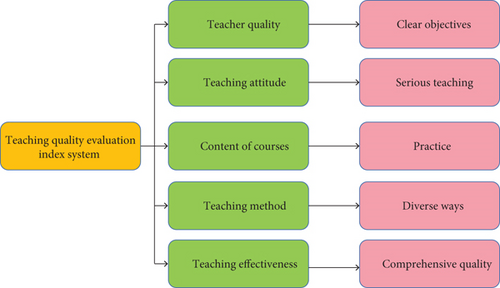
To make the weight setting more scientific and reasonable, the gradient descent method is used to adjust the weights. Following the establishment of the assessment index system, the weighting system that corresponds to the index system should be more scientific [15]. The main goal of process assessment is to create a more comprehensive, objective, scientific, and accurate assessment system for the comprehensive English curriculum specialty, to assist teachers in feeding back information in real time during the instructional process, and to more effectively reform instructional management in order to ensure English curriculum instruction quality [16]. Figure 2 depicts the common structure.
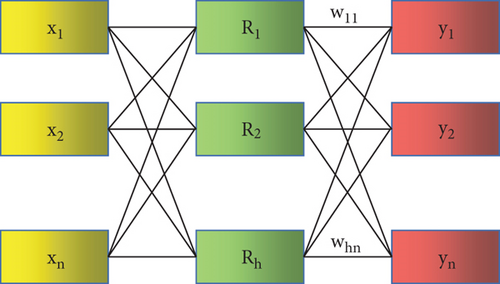
When constructing the network instructional platform, we will never pursue the new and strange network technology but reasonably select computer technology to support the instruction process and management, pay attention to the appropriate application of new technology in instructional activities, and better reflect the instructional thought through technology [17]. In distance education, advanced and appropriate computer technology is used to vividly present the instructional content on the network instructional platform, and the instructional methods that can stimulate students’ interest are chosen to provide flexible and convenient interactive ways, which are not only the interaction between teachers and students but also the interaction between instructional resources and students, providing flexible and diverse advanced instructional methods [18]. Aimed at the assessment of English instruction quality, the structure of the RBF neural network based on genetic algorithm optimization is shown in Figure 3.
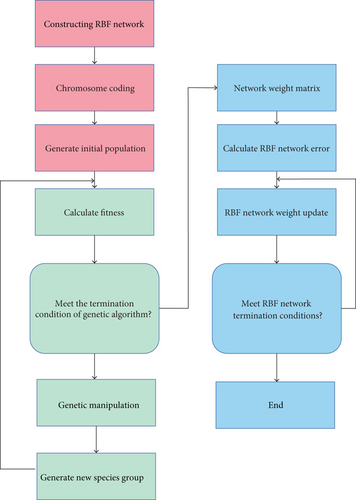
In the process of weight setting, we can first establish the weight set by the expert assessment index, build the BP neural network model learning network through the powerful function of MATLAB toolbox according to the expert index weight, input the weight set by the expert, and adjust the weight set by the expert through network training according to the function of the BP neural network model, so as to minimize the error. The weight is relatively more reasonable [19].
2.2. Teacher’s Instruction Quality Assessment Based on MATLAB
The intensity of process assessment can be difficult to grasp at times, and how strong the assessment is can reflect changes in students’ learning, while it is also convenient for teachers to grasp students’ learning situations in real time and improve their instructional methods to the greatest extent possible, which always makes teachers feel difficult to master [20]. MATLAB is known for its powerful functions, simple and efficient programming, and so on. It can write a variety of subroutines using network training and weight adjustment rules, and users can call them directly based on their needs, greatly increasing efficiency. The general process of neural network solution is depicted in Figure 4.
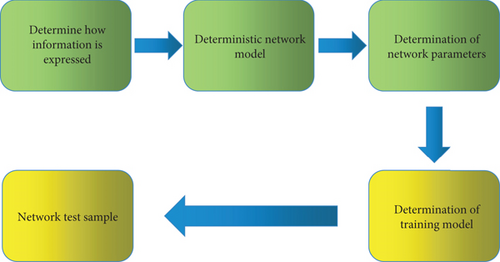
In order to make the instructional activities of online courses based on cloud computing operable, before the online class of the JAVA language programming course starts, the learning needs are carefully analyzed through the learning guidance module of the online instructional platform and the student situation table [21]. According to different actual situations and the instructional requirements of the course itself, the highest and lowest goals and corresponding instructional plans of this course are formulated. Students are required to formulate personalized instructional goals and instructional plans according to their actual situations, so that students can participate in the design of online courses [22]. The cloud computing platform provides rich and flexible instructional forms and learning tools, thereby promoting effective instructional interaction and student learning in distance education and constructing rich dynamic resources for online courses. The main function design of the network instructional platform based on cloud computing is shown in Figure 5.
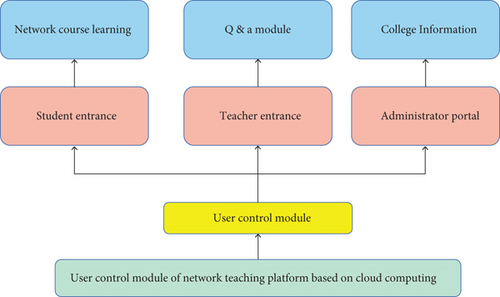
The hierarchical instruction quality assessment index system is a hierarchical structure, including 40 secondary indicators. In order to reflect the specific data information of instruction, 6 primary indicators are the induction of secondary indicators, reflecting the six aspects of instruction quality assessment [23].
The MATLAB7 toolbox takes neural network [24] as theoretical support and constructs network activation function. Convert the calculation of network output into the call of activation function. In the process of genetic algorithm optimization, most new chromosomes are obtained by crossover operation, which is the core of genetic optimization. The MATLAB-based network instructional platform not only emphasizes the design and planning of instructional content but also emphasizes the design and planning of instructional objectives and instruction process, as well as the importance of teachers and students working together to design the network classroom in order to stimulate students’ initiative to construct knowledge. The neural network-based assessment system for teachers’ instruction quality first uses the data from various assessment index systems for teachers’ instruction quality assessment of various disciplines and specialties established in the previous chapter as input samples, then builds and trains the network using the BP neural network, and finally, the assessment network is tested. Finally, the appropriate conclusion is reached [25]. Interactive dynamic assessments are highly sensitive to the learner’s zone of proximal development and focus on the development of an individual learner’s abilities or even the development of a learning group’s abilities, without regard to effort in the process or preset endpoints. The nonlinear mapping from the input assessment index to the output assessment result is the teacher’s instruction quality assessment system. A three-layer BP neural network will be used, which can approximate any mapping relationship with arbitrary precision and is good at handling nonlinear problems. The instructional module setting “DuyteroPrt” is included in the newly added assessment carrier. Create an assessment form and conduct an evaluation. After the instructional module, conduct a composition test at random. To create a network, use the MATLAB toolbox’s newff function. This function is based on the sample data that has been provided. The number of neurons in the output layer is predetermined; however, the number of neurons in the hidden layer and the training algorithm function must be determined independently [26].
3. Validity Analysis of Formative Assessment Results
3.1. Analysis of Instructional Quality Assessment Results
Some colleges and universities use the student assessment method, with students as the primary assessment subject; others use the expert assessment method, with experts providing assessment indexes and standards. Furthermore, some colleges and universities use peer assessment in conjunction with teacher self-assessment to evaluate teachers’ instruction [27]. Students’ learning effect is tested by formative assessment, which means that not only the test scores of students’ learning should be used as a single effect analysis but also the attitude of students’ learning behavior and learning performance should be used as the basis for formative assessment [28]. Figure 6 depicts the comparison of the model’s mean square error.
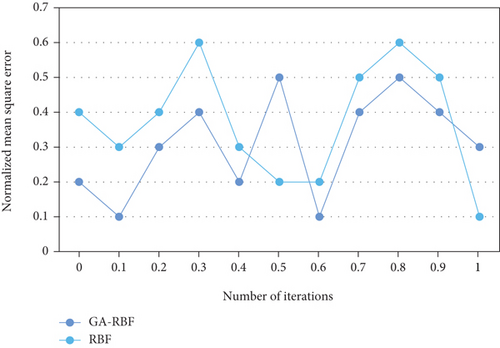
Process assessment considers the entire learning process and all of a student’s learning experiences and believes that all valuable learning outcomes should be positively evaluated. This type of assessment will not only measure students against a single, rigid standard, but will also evaluate each student’s learning effect and academic mastery based on their individual performance during the learning process [29]. Because teachers and students are separated by distance and it is difficult to communicate face-to-face in distance education, it is easy to formalize and rigidize understanding and achievement of instructional objectives. Students are generally aware of formative assessment methods. Different evaluation index systems should be used for different evaluation objects. The key points of index setting should be differentiated based on the discipline’s characteristics. We should put as many factors that have an impact on the evaluation results into the index system as possible during the process of establishing the evaluation system, in order to make the evaluation index system as perfect and comprehensive as possible.
The reason why the school takes attendance, homework, classroom question answering, oral English, and classroom notes as assessment means is to ensure students’ participation and enthusiasm in learning English. Teachers not only pay attention to students’ academic performance and learning results but also judge students’ learning interest, learning style, learning attitude, learning motivation, learning strategy, learning psychology, and even activity participation through questionnaire, question and answer, observation and recording, work analysis, and testing [30]. The proposed English assessment index principal component analysis method is used to analyze the assessment index of English instruction quality, and the index with the greatest contribution to the assessment of instruction quality is selected. The results of principal component analysis are shown in Figure 7.

It is difficult to change the instructional content dynamically. Instructional assessment is an assessment to improve the quality of instruction. It is mainly based on the school management department, adopts certain assessment methods, and takes students as the center to evaluate instructional activities. Instructional assessment is of great significance in the whole instructional activity and helps to improve the quality of instruction. In instructional activities, some “uncertain knowledge” jointly created by teachers and students will also be generated. It is not fixed or completely predetermined, but dynamic and evolving. Therefore, the instructional content cannot be fully prebooked.
3.2. Analysis of Teacher Instructional Quality Assessment Model Based on Artificial Neural Network
In the traditional evaluation system of teachers’ instructional quality, the evaluation subject is often too single, and the evaluation is always not comprehensive enough. The content of the evaluation object is monotonous, and the corresponding weight of the evaluation content is set according to the feeling and preference of the leader. This evaluation system is obviously thin, incomplete, unscientific, and unreasonable, and of course, the results are inevitably unreliable. This kind of predesigned instruction imprisons the development of students’ thinking and also restricts the development of teachers’ personalities. The model assessment accuracy curve is shown in Figure 8.
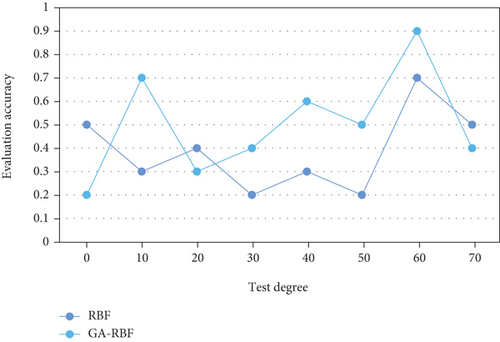
In order to establish a scientific, reasonable, and objective assessment system, we must use a comprehensive approach that combines quantitative and qualitative data. Process assessment combines instructional and assessment elements from time to time so that teachers can spot flaws and areas that need to be addressed in students’ learning processes. Such an assessment system can not only confirm students’ progress in the learning process in a timely manner but also allow teachers to guide students’ learning directions and methods. It can also correct students’ learning problems and deficiencies in a timely manner. Students’ learning enthusiasm improves dramatically, their learning experience grows steadily, and they gradually develop the correct learning style, which significantly improves the quality and impact of learning.
In the process of establishing the assessment index system, we need to adopt a comprehensive way of combining quantitatively and qualitatively to establish a scientific, reasonable, and objective assessment system. Process assessment combines instruction and assessment from time to time, so that teachers can timely see the shortcomings and areas that need to be improved in the learning process of students. Such an assessment system can not only timely affirm the achievements of students in the learning process but also enable teachers to guide students’ learning directions and methods; it can also correct students’ problems and deficiencies in learning in time, as shown in Figure 9.
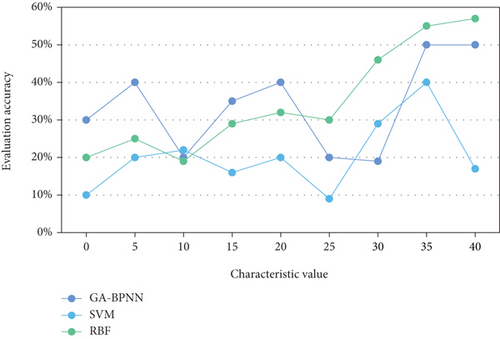
There are many complicated factors involved in establishing a system for evaluating the instructional quality of teachers, some of which can be grasped and others cannot. As a result, in order to establish a scientific, reasonable, and objective evaluation system, it is necessary to combine quantitative and qualitative methods during the process of developing the evaluation index system. The establishment of a reasonable model of a teacher’s instructional evaluation system can help the school understand the teachers’ implementation of instructional tasks and macrocontrol, as well as enable teachers to modify and improve the instructional plan in real time based on the instructional effect.
This kind of generation is a reflection of the real experience of the students, and it is a very precious instructional resource that can be reused by teachers, that is, the “generative resource.” The assessment results under different sample numbers are shown in Figure 10.

For different assessment objects, different assessment index systems should be adopted. The traditional method only reflects students’ learning effects from one side, but it cannot fully reflect students’ multiple intelligences. However, the implementation of process assessment can go deep into all aspects and different levels of students’ learning and comprehensively describe and evaluate students’ learning situation and learning effect from different angles. Such assessment is also more authoritative and convincing. According to the characteristics of the discipline, the focus of the index setting should be differentiated. In the process of establishing the assessment system, it is necessary to put all the factors that affect the assessment results into the index system as much as possible, so that the assessment index system is as complete and comprehensive as possible.
4. Conclusions
This paper constructs an English instruction quality assessment model based on the genetic algorithm optimized RBF neural network. Due to the use of cloud computing architecture, the designed network instructional platform can more flexibly realize the interactive function, provide strong support for the development of network classroom generative instruction, and form a benign interactive distance education ecosystem among teachers, students, and instructional platform. It can deal with data of any complexity, can build neural networks, and has strong self-learning ability. It can approach any complicated nonlinear relationship problem with any precision. It can build a model for nonlinear processes without knowing the reason for data generation.
The method of procedural assessment is effective. It can not only fully reflect students’ learning processes and comprehensively test students’ usual learning performance and learning effect but can also assist teachers in assessing students’ mastery of learning content and providing timely feedback on instructional effect. The instructional effect can be determined based on the model’s output as long as the neural network is fed new assessment index data. To achieve high accuracy assessment of English instruction quality, principal component analysis is used to screen the assessment indexes, and the weight parameters of the RBF network are optimized by a genetic algorithm. The value of process evaluation is undeniable. It can not only fully reflect students’ entire learning process but also comprehensively test their learning performance and effect, as well as assist teachers in checking students’ mastery of learning content and providing timely feedback on instructional effect. However, it can also assist students in deepening their understanding of the problem, improving their perceptual knowledge, improving their answering skills, and identifying knowledge flaws during the learning process.
Conflicts of Interest
The author does not have any possible conflicts of interest.
Acknowledgments
This study was supported by the Research on the Construction of Higher Vocational English Curriculum under the Framework of Humanistic Quality WYJZW-2020-1094.
Open Research
Data Availability
The data used to support the findings of this study are included within the article.




